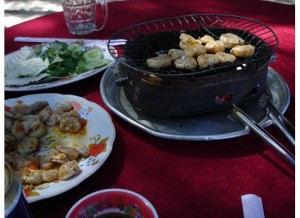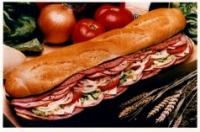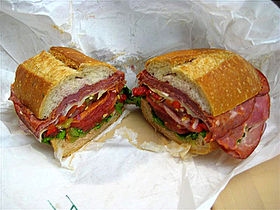It Must Have been Something I Ate
The Carnival of Genealogy theme this month is food. This week’s post is a slight reworking of a post of the same name that I published in May of 2009.
I need a hoagie, from Lee’s, the Cheltenham, really; I need one, right now. Other people who grew up in Philadelphia need a cheesesteak fix occasionally, not me, I need that hoagie. If you’re driving up this way and you have a cooler they’ll pack it up for you, with the meat wrapped in aluminum foil and the special oil, the onions, and the hot peppers in separate little containers.
If you read my posts you won’t even bother to ask how this relates to genealogy. We will get there eventually.

Actually it’s just a short trip from food to genealogy. Food roots us in time and place and culture. I have never met anyone who doesn’t have at least one childhood food memory and most people are more than willing to play the Ten Best Meals You Ever Ate game.

If you’ve never played please remember that a meal isn’t just about food; it’s also about where and when you ate it and the people who shared it.
As much as the fast food industry has tried to obliterate it America is still a land full of regional cuisines and specialties. For me it’s the hoagie and the cheesesteak and water ice. Water ice is called Italian ice here in New Haven. It’s very fine ice with flavoring. You eat it out of a paper cone or cup.

Lemon is traditional, but now you can get mango or cantaloupe or just about any fruit flavor.
Pat and I went with a friend to her hometown of Binghamton, New York and had our first spiedies. That’s marinated lamb or beef done on the grill and put on an Italian roll.
I am partial to the vinegary pulled pork that constitutes barbecue in North Carolina, but I won’t turn down Texas beef.
I grew up in the East where salmon is salmon. Then I went to the Northwest where the debate over whether we should get Silver or King raged. I don’t remember which we had, but we caught it ourselves and it hit the plate a few hours later. This is an entirely different fish than the red colored stuff from the grocery store.
Don’t even ask a New Yorker about the best bagels or corn beef unless you have a lot of time. Even though I told you not to ask I must say here that a bagel is not just a piece of round bread. A bagel requires chewing, and despite what your local grocery store or Dunkin’ Donuts or my daughter may tell you, there is no such thing as a blueberry bagel.

Sorry, it’s a sore point.
I could go on forever, but you get the idea.
What about time? I hate to date myself, but when I was young the microwave oven did not exist. In those dark days of yore fast food at home consisted of the TV dinner, a metal tray with compartments of different foods that had to be heated in the oven. The fast part came from not having to prepare it yourself. Food fads come and go, the ones you remember best will probably date your teenage years fairly accurately.
And now we come to culture. The closer you are to the immigrant generation the more familiar you are with the traditional food of the home country. Immigrants clung to the foods of their homelands; those who came to the new world to turn a fast buck and go home would eat whatever the local environment provided. If you’re going back it doesn’t matter; if you’re staying food is a way to preserve your roots. English colonists tried to grow wheat and eat wheat bread in land that didn’t grow wheat well and where corn thrived and was plentiful. They turned their noses up at lobster too.
Food from our heritage gets handed down through generations. Is there anyone who doesn’t have a grandmother or a great-grandmother who cooked these wonderful foods without a recipe? Even if you have a recipe it doesn’t taste as good; memory is a powerful flavor enhancer.
Today it seems like everyone I know is picky about food. Meat, not meat, organic or not, cheap or expensive, exotic or familiar. But as we try to keep our families healthy and listen to our cardiologists let’s remember what makes a great meal– friends, family, tradition, flavor, laughter and much more. Great meals make great memories.
Here’s a link to the blueberry bagel pic. The photographer agrees with me.



I just had my first Philly cheesesteak a couple a weeks ago, and let just say it’s a good thing I don’t live in Philly. I’d be eating them all the time. You are so right about food tying immigrants to their roots in the old country. My grandmother came to the U.S. at the turn of the last century, and here we are still eating Polish food on the holidays. Thanks for the great post!
Great post Judy.We lived in a Jewish neighborhood for a bit when I was a kid and remember the bagels the local deli sold and the onion rolls. Man, this COG is making me hungry!!
Thanks Nancy,
I agree, once you are committed to stay in a new country with little hope of ever seeing your old home again anything familiar is welcome.
About food an immigrants, I think food brings comfort, too. For those poor immigrants, away from everything they knew and loved, home food probably helped soothe their souls. Great post. Thanks for sharing.
Thanks Jasia, I’m glad you liked it and thanks for managing the Carnival
What a great article, Judy! I can’t relate to the specific foods you mentioned (I’m from the Midwest) but I can relate to having memories of wonderful foods shared with family and friends. Thanks for triggering those memories!
And thanks for participating in the Carnival of Genealogy!
Thanks Susan. I let my daughter have a raisin bagel when she was young and I think that’s what turned her to the dark side.
Judy
AMEN! To every word. Especially that round thing studded with blueberries (no raisins in bagels, either). And also to the spiedies. Not sure if I’ll get to this Carnival, but if do spiedies will make an appearance.